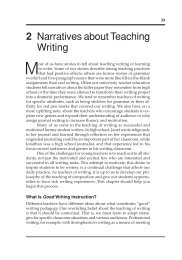Graphic novel Spread - National Council of Teachers of English
Graphic novel Spread - National Council of Teachers of English
Graphic novel Spread - National Council of Teachers of English
- No tags were found...
You also want an ePaper? Increase the reach of your titles
YUMPU automatically turns print PDFs into web optimized ePapers that Google loves.
2 James Bucky Carter<br />
<strong>of</strong> librarians have begun to pay <strong>of</strong>f and to extend outside the domain <strong>of</strong><br />
library conferences and publications. Books such as Michele Gorman’s<br />
Getting <strong>Graphic</strong>: Using <strong>Graphic</strong> Novels to Promote Literacy with Preteens and<br />
Teens (2003) and Stephen Weiner’s 101 Best <strong>Graphic</strong> Novels (2001) and<br />
increased interest on behalf <strong>of</strong> NCTE journals and other education periodicals<br />
have brought graphic <strong>novel</strong>s into the mainstream. A recent<br />
NCTE statement on multimodal literacies (2005) seems likely to encourage<br />
the growing presence <strong>of</strong> graphic <strong>novel</strong>s in the classroom.<br />
The media are helping to bring comics and graphic <strong>novel</strong>s to the<br />
fore as well, with film adaptations <strong>of</strong> graphic <strong>novel</strong>s such as Ghost World,<br />
Road to Perdition, From Hell, and American Splendor, which are consistently<br />
raking in major returns for moviemakers. The popularity <strong>of</strong> these films<br />
shows that there is much more to these books than superheroes in leotards<br />
and capes. At the same time, movies based on superheroes also<br />
remain popular, helping to engage a new generation <strong>of</strong> young fans. This<br />
engagement might help teachers to accept the presence <strong>of</strong> a comic in<br />
class. Likewise, the efforts <strong>of</strong> classroom teachers and university-level<br />
educators have drawn the attention <strong>of</strong> mainstream media. For example,<br />
<strong>National</strong> Public Radio’s broadcast <strong>of</strong> Morning Edition on April 8, 2005,<br />
and a broadcast <strong>of</strong> CBS’s The Early Show on March 25, 2005, both featured<br />
stories about a Maryland school district’s acceptance and promotion<br />
<strong>of</strong> comics in the classroom (Hughes, 2005) as a means to get otherwise<br />
disinclined or struggling students motivated about reading. The<br />
Christian Science Monitor has picked up on the trend as well (see “‘Hamlet’<br />
Too Hard Try a Comic Book” in the issue <strong>of</strong> October 12, 2004). On<br />
March 3 <strong>of</strong> the same year, USA Today published an article entitled<br />
“<strong>Teachers</strong> Are Getting <strong>Graphic</strong>” (Toppo, 2005). This is but a sampling<br />
<strong>of</strong> the many articles that have appeared in the past few years.<br />
Students are doing their part to promote graphic <strong>novel</strong>s as well.<br />
Manga, the Japanese equivalent <strong>of</strong> the graphic <strong>novel</strong>, is amazingly popular<br />
with students (Wilson, 1999). In 2003, when I noticed one <strong>of</strong> my sixth<br />
graders reading a manga, I polled the class. Seventy-five percent <strong>of</strong> them<br />
had read and enjoyed a manga recently and 80 percent knew what a<br />
manga was. Informal as they are, those numbers included female students,<br />
who flock to manga (Bucher & Manning, 2004; Reid, 2002), and<br />
they were taken at a middle school that is not in New York or Los Angeles,<br />
but in a tiny town in rural North Carolina. Manga are so popular<br />
now, as are graphic <strong>novel</strong>s, that major book chains such as Barnes and<br />
Noble give them their own sections.<br />
Of course, to persuade most <strong>English</strong> language arts teachers, and<br />
perhaps you, the reader, to consider graphic <strong>novel</strong>s as serious resources
















